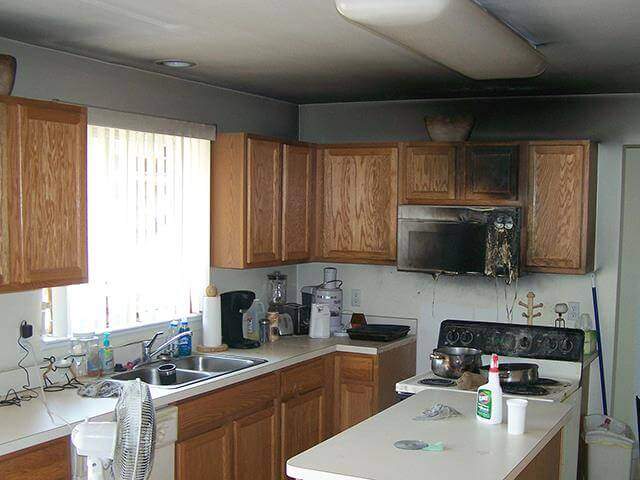ABBOTTS BLOG
Dangers of Toxic Smoke in Fire Damage

If you’ve recently suffered from a fire in your home, you are well aware of what a mess it is to clean up. You aren’t just looking at damage the fire caused to the structure and your possessions. You’re also looking at water damage from the water used to put out the fire and possibly chemicals from a fire extinguisher if you used one. The visible damage from a fire can be overwhelming.
 Unfortunately, the damage caused by a fire goes beyond that visible to the naked eye, and that damage can actually be the most dangerous because it can go untreated for years. It already takes so much time and effort to clean up the visible mess left behind in a fire’s wake that many homeowners neglect to consider toxic smoke and soot damage. But if you can smell smoke and fire odors after cleanup is done, or if your fire cleanup crew didn’t take certain steps to get rid of microscopic contaminants, your health and that of your family could be at risk.
Unfortunately, the damage caused by a fire goes beyond that visible to the naked eye, and that damage can actually be the most dangerous because it can go untreated for years. It already takes so much time and effort to clean up the visible mess left behind in a fire’s wake that many homeowners neglect to consider toxic smoke and soot damage. But if you can smell smoke and fire odors after cleanup is done, or if your fire cleanup crew didn’t take certain steps to get rid of microscopic contaminants, your health and that of your family could be at risk.
When a house fire occurs, the soot and smoke created are not clean. Unless your home and belongings are entirely made of untreated wood, you’re looking at a lot of different materials that have now been broken down into tiny, microscopic particles and spread across your home and belongings. In fact, an average house fire can release tens of thousands of microscopic particles and toxic gases into the air, which either remain in the air or settle onto your possessions. Consider the variety of materials that burned in the fire — plastic, electrical, synthetic, and so on. Each item you own creates a different mixture of chemicals when burned, and many of them are toxic.
Here, we will take a look at some of the most dangerous chemical particles left behind after a fire, and why fire odor and particulate cleanup is so important to ensuring your family’s safety.
What Gets Left Behind
When it comes to restoration after disasters in your home, you’ve likely heard about a lot of different pathogens that might be lying in wait to make you sick. Huge amounts of attention and care are given to mold, lead, asbestos, and potential bacteria and toxins in unclean water or sewage. Unfortunately, the same level of care is not always given to the tiny, dangerous particulates left behind after a fire.
Toxic volatile organic compounds, or VOCs, are the compounds created when certain materials are burned in a fire. VOCs can remain in the air, which is one reason air cleaning and ventilation is so important after a fire. Many of these particles are so small that they can infiltrate the lungs and be absorbed into the skin. These particles and others left behind from toxic smoke have been linked to a variety of serious health conditions.
Because of the wide variety of things that might have burned in your home, the list of potential toxins, carcinogens, and so on, is practically endless, but some of the most common (and a brief description of their dangers) are:
- Arsenic: Highly toxic chemical that can cause poisoning through inhalation of absorption through skin.
- Sulfur Dioxide: Causes dangerous respiratory and circulatory symptoms that can easily lead to death in the elderly and infants.
- Benzene: A carcinogen linked to multiple forms of leukemia and other cancers.
- Mercury: Can cause permanent damage to kidneys, brain, a developing fetus, and to nursing infants. Effects on infants can include severe brain damage.
- Hydrogen Cyanide: Depending on the volume inhaled, symptoms can range from headaches, dizziness, and gastrointestinal upset to seizures and death.
- Hydrogen Sulfide: Acute exposure to this chemical can cause symptoms ranging from nausea, problems with equilibrium, headaches, and tremors to unconsciousness and death (if exposed to high concentrations).
- Formaldehyde: A known carcinogen, linked to nasopharyngeal cancer and leukemia.
- Hydrogen Chloride: Causes irritation to tissue, ranging from throat irritation at low levels of exposure to breathing problems, fluid in the lungs, and possibly death at higher levels.
- Phenol: Leads to systemic poisoning. This corrosive chemical causes burns at the site of contact, and other symptoms, including gastrointestinal problems, hypotension, arrhythmia, tachycardia, and pulmonary edema. Can cause nerve damage and organ damage leading to death.
How to Get Rid of These Contaminants from Toxic Smoke
 So, you know now the dangers and toxicity of fire smoke once the fire has been extinguished. And these particulates are very dangerous, indeed. But is there any way to be safe living in your home again? Thankfully, with a thorough cleaning of all of your porous possessions, flooring and walls, and the air in your home, the answer is yes.
So, you know now the dangers and toxicity of fire smoke once the fire has been extinguished. And these particulates are very dangerous, indeed. But is there any way to be safe living in your home again? Thankfully, with a thorough cleaning of all of your porous possessions, flooring and walls, and the air in your home, the answer is yes.
The simple truth is that you need a fire damage restoration company that is not just interested in getting the job done on a surface level, but is committed to truly returning your home to a pre-loss condition. This includes getting rid of particulates and gases in the air, and microscopic chemical particles that are now coating your furniture and other surfaces in your home.
At Abbotts Fire and Flood, we take this part of the restoration process very serious. Our process includes smoke removal, ash and soot elimination, and toxicity removal, ensuring that you and your family can be safe in your home. We will utilize industrial HEPA air purifiers, decontamination products, sanitizers, and antimicrobials to get rid of any dangerous contaminants.
Abbotts specializes in making spaces that are unsafe after a disaster safe again, and our treatment of your home after a fire is no different. Whether you recently experienced a fire and have extensive cleanup needs or you are concerned that you still have contaminants lingering from a past fire, we are here to help. Contact us today for a free consultation.
![]()

